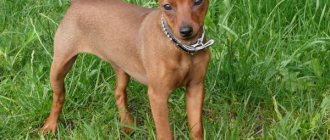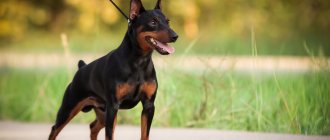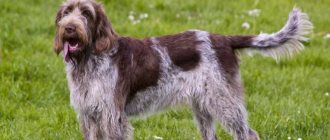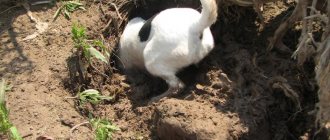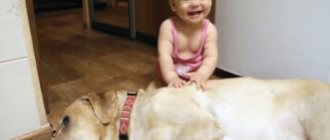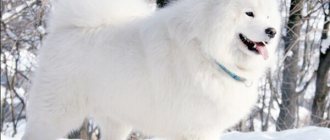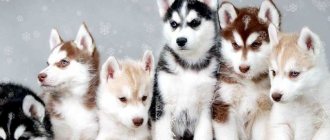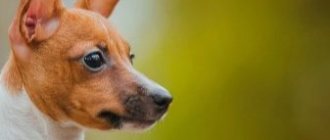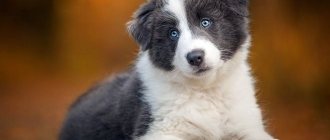Education and training
It is better to start raising a pet from the moment it arrives in the family.
This rule applies to any animal. A positive aspect of raising a Belgian Griffon is its natural intelligence. You won't need much effort to get him to behave decently.
But it should be remembered that the dog’s character is strongly focused on the owner. She finds it difficult to remain alone even for a short time. Therefore, when planning a long trip, you should seriously think about how and where the dog will spend this time. The best solution would be to take it with you. Otherwise, the dog may be seriously offended by the owner and his behavior will deteriorate.
In addition, you should not constantly keep your animal in a cage at home. They really need physical contact. Otherwise, it is possible to develop depression and commit hooligan acts in order to attract attention.
Griffons quickly master any commands. The main thing in training is regularity, gentleness and encouragement.
Health
- Due to the uncertainty surrounding the griffon's ancestry, it is very difficult to determine their genetic weaknesses. In general, this dog is not particularly sickly, with strong immunity and health. In any case, this breed is considered a long-liver (13-15 years, the oldest is 20 years).
- There are a number of diseases that are often found in Belgian Griffons. However, with proper care and, if necessary, treatment, the pet is not in danger.
Vaccinations
Vaccination is required for all domestic dogs. It provides immunity from dangerous infectious and viral diseases. Usually the cost of vaccination does not exceed 1000 rubles, but this depends on the drug.
Before the procedure itself, it is necessary to cleanse the pet’s body of worms and other parasites using special tablets (purchased at a pet store). You also need to maintain home care, because puppies are most susceptible to dangerous bacteria. After vaccination, it is important to provide the griffon with an incubation period (14-15 days).
There are two types of basic vaccinations for dogs:
- Complex vaccination (enteritis, leptospirosis, para-influenza, plague) is done at 1.5, 2.5, 6, 12 months consistently and is updated every year.
- Rabies vaccination is required for export abroad ; the puppy is vaccinated at 7 months and annually thereafter.
All procedures are carried out in veterinary clinics by specialists. It is also necessary to obtain a veterinary passport - the main document of the pet. All medications that your dog has taken or is taking, in particular, anthelmintics and flea medications, will be entered there.
Diseases
Representatives of this breed are characterized by several classifications of diseases:
- Eye diseases: extra eyelashes, conjunctivitis, loss of eyeballs (weak eye muscles), cataracts, problems with the eyes;
- Dislocations of the kneecaps (most often due to unscrupulous breeders and poor conditions for keeping the puppy);
- Viral and infectious diseases (if all vaccinations are available, the risks are reduced to 10-15%);
- Parasites (both intestinal and cutaneous);
- Difficult pregnancy and childbirth (due to the small size, it is sometimes difficult for a female to bear and give birth to healthy puppies, veterinarians help with this).
Since these dogs are not particularly prone to various health problems, it is important for the owner to monitor the pet (feeding, coat) and the likelihood of losing the animal will decrease.
Breed description, standards, appearance
Belgian Griffons are small, bony dogs with elegant movements and an expressive face. According to the international classification, the breed belongs to group No. 9 “Companion dogs and toy dogs” and section No. 3 “Small Belgian dogs” without testing working qualities.
Size and constitution
Belgian Griffons are small dogs with pronounced sexual dimorphism. The height of the female varies between 16-18 cm at the withers and weighs 3.5-5 kg. The male grows up to 18-20 cm and weighs 4.5-6 kg.
According to FCI standard No. 81, a typical representative of the breed must have the following characteristics:
- The head is wide in the skull, large relative to the body with a rounded forehead and a clear stop. The nose is wide, black, located at the same level as the eyes. The muzzle is short, upturned, no more than 15 mm long. The lips are well pigmented, tightly closed and closely fitting to the jaws. The lower jaw is wide, curved, protruding beyond the upper. Bite – snack.
- The ears are small, set wide and high, semi-erect with tips hanging forward. They can be docked and have a pointed shape.
- The eyes are expressive, round, widely set with a brown iris and tightly drawn eyelids.
- The body is almost square with raised withers, a strong, short, level back, a muscular, slightly convex loin and a wide, slightly sloping or straight croup. The neck is of moderate length, blending smoothly into the shoulders. The chest is deep, wide with well sprung ribs. The stomach is slightly tucked.
- The limbs are bony, parallel, set wide apart with rounded, compact paws, tightly clenched toes, dark nails and thick pads. Movement is powerful with strong drive from the hind legs.
- The tail is set high and carried upward. Does not curl into a ring and does not touch the back. Can be docked at 2/3 of the natural length.
Any deviation from the norms prescribed in the breed standard is considered a fault, the severity of which depends on the severity and impact on the functionality and health of the dog.
Disqualifying faults include:
- obvious physical and behavioral abnormalities;
- any colors of the nose, except black;
- long upper jaw;
- visible tongue with closed mouth;
- skewed lower jaw;
- cryptorchidism (in males).
Color and coat type
The Belgian Griffon is a wire-haired breed with a developed down, slightly wavy spine and pronounced decorative hair. The dog's head has characteristic eyebrows, mustache and beard.
According to the standard, the Belgian Griffon can have only two color options - black and black and tan. In the second case, reddish-brown markings are present on the dog’s body. They are localized above the eyes, on the chest, cheekbones, lower part of the tail, chin, front and hind limbs, as well as on the inner surfaces of the thighs and legs.
Mixing black and red colors is acceptable, but not desirable.
Walk
- This breed is quite active. Physical activity is important to them: games, jogging, training. Of course, 10-20 minutes a couple of times a day is enough for a “walk”, but then all the main physical activity of the pet will take place in the apartment.
- With insufficient walks, Belgian Griffons begin to feel sad ; breeders claim that the lack of fresh air negatively affects the life expectancy of these dogs.
- The best option would be joint tourist trips , morning and evening jogging. Sometimes even the most banal shopping trip can become a real adventure for a griffon.
- For walking, you should choose a harness and tape measure. Leashes and collars are not recommended: due to its small size, such a dog can be strangled. You can only release it when the pet knows the basic commands and is accustomed to walking next to its owner. Otherwise, he may run away.
It is important to let your pet communicate with the outside world: sniff the ground, other dogs, people. However, you should watch what your pet chews and licks.
Brief history of origin
Belgium is considered the birthplace of the breed, and its history began 500-600 years ago. The Belgian Griffon is thought to have evolved from the Ruby Cavalier King Charles Spaniels and Affenpinschers, with some pug, schnauzer and Yorkshire terrier genes mixed in.
At first, the ancestors of these dogs lived in stables and specialized in killing rodents that ate horse oats. But by the 15th century, the amusing Belgian griffons became favorites of representatives of aristocratic circles and emphasized their high social status.
This fact is confirmed by multiple paintings depicting noble ladies in the company of similar dogs.
The first exhibition at which Belgian griffons were demonstrated took place in 1880. But the breed received official recognition only in 1904.
A haircut
The hard and thick coat of the griffon needs not only combing, but also trimming. This procedure is carried out two to four times a year. If you do not pluck out the old wool, the entire coat will become covered with tangles, and the floor will be strewn with hair.
A pinched dog looks neat, the contours of an athletic body are visible.
In addition, you need to trim the facial hair regularly. Such procedures require concentration, time and skill. Therefore, it is better to entrust trimming and cutting to professionals. If the owner decides to carry out the procedure on his own, it is worth contacting a salon, where a specialist will show you which zones to distribute trimming into, what is the best way to carry it out and at what time.
After the procedure, some dogs may experience skin problems: minor bruises, pimples, sores. Usually, they go away on their own, but it is better to wash them with a special antiseptic shampoo diluted with water. If problems persist, you need to visit a veterinarian.
Grooming
The Belgian Griffon's coat is hard and thick. Despite this, they do not shed or emit unpleasant odors. However, because of this, the dog needs to be trimmed (plucked) 2-3 times a year to remove old fur, this is especially important during seasonal shedding.
- There is no need to cut your pet's hair (except for the areas around the eyes).
- In addition, it is important to comb the animal free of debris using soft brushes 2-3 times a week . Using a stiff brush – 3-4 times a month. Bathing is allowed no more than once every 3 months (only with the help of special shampoos).
- The griffon's claws need to be trimmed every 2-3 weeks so that they do not wear down during walks. Carefully monitor the condition of your eyes, ears and nose. If possible, clean every 2-3 days .
- Particular attention is paid to the beard : after each meal, it is necessary to wash the coat and comb it so that individual hairs do not stick together and dry out.
- After walks, you need to wash your paws and clean the pads of small debris.
Vaccinations
Innate immunity in puppies lasts up to 2 months. Then they need to get a comprehensive vaccination (against plague, hepatitis, leptospirosis, rabies, infectious enteritis). Before the injection, the animal is given anthelmintic drugs.
The first vaccination is usually complex. It protects your pet from several of the most common diseases at once. However, the full dose of the vaccine is administered to the puppy in two doses. Between injections take a break of 2 weeks.
All Griffon vaccinations are given before the age of four months. The dog is vaccinated before or after the change of milk teeth. At 10 months the animal is vaccinated again. A year later, another vaccination is given.
How to choose a puppy
It is best to buy a puppy at the age of 2 months. He should have thick, rich-colored fur, a large body, and a developed chest. A good Belgian Griffon puppy should be heavier than its brothers.
The baby must stand on its own paws and have a flat back. When choosing a puppy, you need to focus on the official description of the breed. Griffons should have even teeth (6 incisors in each jaw), a correct bite, a not very short nose, dark, lively and large eyes.
By 2 months, a Belgian Griffon puppy should be sociable, not afraid of strangers, and wagging its tail.
It is not advisable to adopt a dog that trembles at the sight of a stranger. It will take too much time for such an animal to adapt.
Belgian Griffon puppies must be vaccinated in accordance with the vaccination schedule. When purchasing an animal, you need to ask the seller for a veterinary passport.
The Griffon puppy should not have any discharge from its eyes or nose. The skin on the tummy should be clean, without scratching. An important condition is the absence of parasites. It is not advisable to buy a Belgian Griffon at a poultry market; the animals sold there may be sick. It is best to buy a puppy from a good kennel. In such places, purebred and healthy dogs are sold.
Mating
There are several varieties of griffons. They differ in coat color and body type. Belgian, Brussels Griffon, Petit Brabançon can interbreed.
To get puppies of a certain breed, you need to choose the right partner for mating. Before fertilization, it is recommended to carefully examine the animal and study its pedigree.
Mating is carried out when males reach 12 months, and females - 15 months, later, but not earlier. Belgian Griffon puppies born before this date will not receive documents confirming the quality of the breed.
It is not advisable to breed a dog during its first heat. It is first recommended to take your pet to exhibitions and study potential suitors. At the time of mating, the two dogs must be absolutely healthy.
Feeding
Petit Brabançon is suitable for premium industrial food “for decorative and small breeds of dogs.” Its benefits lie in the balance of fats, proteins, carbohydrates, vitamins and minerals. Some Petit Brabançons are quite picky about food and refuse dry food .
Preparing natural food is problematic. It must be of super high quality and always fresh. You will need to add a multivitamin. For anyone who is not too lazy to prepare it, we can recommend a set of the following ingredients:
- cereals: rice and buckwheat;
- meat: beef, rabbit, turkey, chicken breast;
- vegetables: carrots, zucchini, pumpkin, broccoli;
- fermented milk products with low fat content;
- high quality by-products.
All other products are prohibited. Food from the human table is strictly prohibited. You cannot mix or alternate dry food and natural food. This can cause pancreatic disease!
How much do puppies cost?
The price of dogs of different breeds is not always the same. It depends on the pedigree of the animals and their exhibition career.
The pet-class Belgian Griffon dog breed costs $200-300. Such animals do not participate in exhibitions because they do not meet the standards. Representatives of the breed class can be valued at $400. True, such dogs have no right to participate in international exhibitions. Show class animals have an excellent pedigree. They cost about $1,000. Such dogs can participate in international exhibitions and compete for the main prize.
Character
Like terriers, Belgian Griffons are considered very loyal dogs. The pet tries to constantly be near the owner, runs after him, needs to communicate with a person, and does not tolerate loneliness well.
The Belgian Griffon dog breed loves to be the center of attention, the animal willingly plays with children. Pets have a balanced character, they rarely come into conflict with strangers or strange dogs.
A properly raised “Belgian” does not bark at guests; he behaves calmly throughout the day.
Belgian Griffons are easy to train and respect the rules established in the home. The animals are clean, love to walk, and are not timid or overly aggressive.
Nurseries
Kennels where Belgian Griffon dogs are bred:
- H'it Ulduz, Mytishchi, Moscow region https://hitulduz.wixsite.com.
- Neo Classics, Mytishchi, Moscow region https://chihuahua.rf.
- Cerberus, Mytishchi, Moscow region (link to website https://www.cerberplus.com.
Belgian Griffons are small, friendly pets that are ideal for keeping in city apartments. The dogs are cheerful and energetic, they have a pleasant, funny face with smart human eyes. Animals will not let their owners get bored; they will cheer up and brighten up the loneliness of elderly people.
Socialization
Representatives of this breed are a little stubborn. It will be difficult for novice dog breeders to teach them order. However, if you are persistent, the animal will become obedient.
Belgian Griffons are sensitive and touchy creatures. If you constantly yell at them, they will become aggressive and start biting. Sometimes they snarl and growl.
Dogs love to play with children, but hate being hugged. The pets are not aggressive, but they hardly tolerate the antics of the kids.
